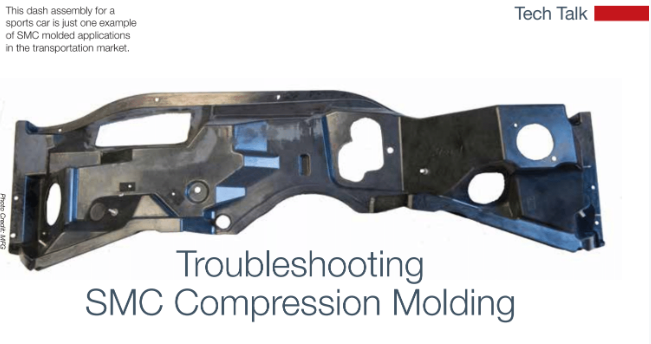Troubleshooting of any type is best done using a systematic process that gathers information about the problem and aims at its resolution. Utilizing an organized approach and documenting what is learned is highly encouraged not only for resolving the current issue, but as reference to help in resolving future issues.
If you have made good SMC parts in the past, then the first step in troubleshooting is to determine what has changed. Begin by examining whether your material and production process are in accordance with documented requirements. Here are some preliminary questions to ask:
- What is the quality of the SMC material? For example, is the maturated viscosity acceptable, is the mat weight and glass content correct, are the gel and cure times as expected and is the material within its shelf life?
- Is the SMC material and its chain of custody robustly controlled during transport, storage and pre-charge staging? Are transport and storage conditions cross-checked, audited and monitored (duplicate temperature measurement, temperature-controlled transport tattle-tales, etc.)?
- Is your die at proper temperatures? Molding temperatures will vary based on the type of resin and the formulation used.
- Are your press operation profile and press closure correct?
- Is the tonnage correct? (Both ultimate tonnage and speed to full tonnage?)
- Are the charge pattern, weight and placement correct?
- Is vacuum assist being used? If so, is the system working properly to provide adequate negative pressure and for effective recovery? Are the vacuum ports plugged or damaged?
- Is there a tool wear/damage issue that is negatively affecting cavity pressure/flow?
- Is inventory management controlled to allow lot and supplier traceability?
Finding the aberrations between good SMC parts and those with a problem should lead to correction of the problem.
If you have verified that the material and process adhere to requirements and there is still a problem, you face a more difficult task. Here, the confined limits of your process contain enough variability to allow both acceptable and unacceptable parts, and you have found the unacceptable portion. At this point, an approach to reducing variation can be used. Consider these questions:
- Can you tighten your parameters? For example, can your die temperatures be within a 5-degree range instead of a 10-degree one?
- Can the gel or cure time be narrowed?
- Are areas of your process uncontrolled and, if so, can you get control of them?
- Can tightened controls be replicated consistently by the press operator (charge preparation, weight, placement, timing etc.)?
There may also be an opportunity to upgrade equipment and add better controls and automation. Temperature sensors in the die can be connected to a programmable logic controller (PLC), which can also connect to your heat source to provide control of your die temperatures. Templets or lasers can be used to provide better repeatability of charge placement. Even better, automate the charge placement. How precise is the scale used for weighing the charge? Is the scale and your other digital equipment in calibration? The addition of a “self-leveling” capability can also help with aesthetic consistency in the case of parts with Class A surface finishes.
I encourage you to avail yourself of SMC troubleshooting guides offered by many suppliers that list defects and possible ways to impact, reduce or eliminate them. (A short list is presented in the sidebar.) You may even have your own in-house guide.


